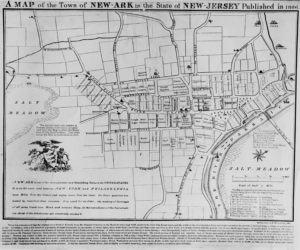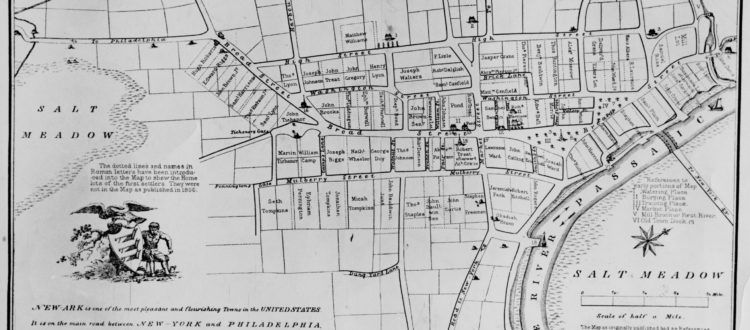Newark at 350: Settlement, Growth, Renewal
The Exhibit
Since Robert Treat stepped ashore with his fellow Puritans 350 years ago, Newark has gone through many changes. For the

The “Shoemaker Map,” a depiction of Newark in 1806. A drawing of a shoemaker appears in the bottom left corner, an indication of the importance of that industry to Newark in the early 19th century.
first century of its existence, Newark was primarily a religious settlement, its inhabitants focused on a life lived according to the dictates of their faith.
After the Revolutionary War, however, the tiny settlement exploded. In the fifty years after 1785, the population of Newark increased from just 1,000 to more than 16,000. New roads, the Morris Canal, and early railroads were all built through Newark, making it an important commercial center.
Newark in the nineteenth century was an industrial powerhouse. From early industries like leatherworking and shoes, it expanded into beer, silver and jewelry, chemicals, electricity, and many others. It attracted inventors and entrepreneurs like Seth Boyden, Thomas Edison, Peter Ballantine, and Edward Weston.
Along with industry came immigrants, mostly from Europe. Italians and Irish and Germans and others arrived in the nineteenth century, seeking work in the city’s many factories. By 1910, seventy percent of Newarkers were either immigrants or the children of immigrants.
Just as the European immigration wave began to abate, another group of migrants started arriving. African Americans from the rural South, fleeing repressive Jim Crow laws, began settling in Newark around the time of World War I. By the mid-1960s, Newark was a majority Black city.
Unfortunately, these newcomers arrived just as the industrial city began de-industrializing. Wealthy factory owners started moving to the suburbs in the 1920s, and the Depression brought further stress to the industrial base. After World War II, middle class residents of Newark joined a nationwide movement to the suburbs. Many of the city’s businesses moved to lower-tax locales.
In the 1950s, Newark attempted to remake itself through “urban renewal,” condemning and bulldozing wide swaths of the city, then replacing what was lost with high-rise subsidized housing. As in other cities where this approach was tried, these high rises proved to be unmanageable magnets for drugs and crime. They were eventually razed.
The events of July 1967 had a profound effect on life in Newark. The civil unrest led to millions of dollars in property damage and the deaths of twenty-six people, but it also helped elect the city’s first African American mayor, and propel a civic activism that continues today.
In the decades since, Newark has tried to overcome the legacy of 1967. Every large residential or commercial development is portrayed as one more step in the “rebirth” of Newark, part of the “Renaissance” heralded by city leaders.
As Newark celebrates its 350th anniversary, we take a look back at the entire 350 years since the founding. And we look to the future, as Newark seems yet again on the cusp of great things.
Program
Opening Reception
Tuesday, January 19, 6:00 – 8:00pm
Main Library, Centennial Hall
Please join us for the opening reception for the exhibition Newark at 350: Settlement, Growth, Renewal and the launch of the program series Newark Lifetimes: Recollections & Reflections. Please RSVP to 973-733-7793 or rsvp@npl.org
Lecture Series
Newark Lifetimes: Recollections & Reflections
The program series will feature local author and historian Guy Sterling in conversation with notable Newarkers
• January 19: Victor Parsonnet, M.D. and Donald Karp, Esq.
Dr. Parsonnet, a cardiac surgeon, pioneered many cardiovascular procedures in New Jersey. Donald Karp is former vice chairman of the Independence Community Bank and former chairman and CEO of Broad National Bank.
• Febraury 18: Joseph DiVincenzo and Armando Fontoura
Joseph DiVincenzo, a graduate of Barringer High School, has been Essex County Executive since 2002. He previously served as an Essex County Freeholder for thirteen years. Born in Portugal, Armando Fontoura attended Newark schools. He served on the Newark police force and later the Office of the Essex County Sheriff. First elected in 1990, Fontoura is Essex County’s longest serving sheriff.
• March 10: Sheila Oliver and Mildred Crump
Assemblywoman Sheila Y. Oliver served as New Jersey’s Assembly Speaker during the 214th and 215th Legislatures and is the first African-American woman to lead a legislative house in the state and only the second African-American woman to lead a legislative house in the country. Municipal Council President Mildred C. Crump was Newark’s first African-American councilwoman and the first female Council president.
• April 12: Benilde Little and Richard Wesley
Benilde Little grew up in the South Ward and attended Weequahic High School where she is a member of the hall of fame. Little’s latest book is a memoir, Welcome to My Breakdown.Richard Wesley lived in the Ironbound and attended East Side High School, where he was added to the Alumni Roster of Superior Merit in 2008. Wesley is currently an Associate Professor in the Tisch School of the Arts at New York University.
• May 12: Kenneth Gibson and Sharpe James
Kenneth Gibson become the first African-American mayor of Newark in 1970. Sharpe James became the first former city councilman and second African-American to be elected mayor of Newark in 1986, serving until 2006.
• June 1: Nell Painter and Willie Cole
Nell Painter is a leading American historian and author. She holds a doctorate in history from Harvard University as well as degrees in fine arts from Mason-Gross at Rutgers and the Rhode Island School of Design. Willie Cole graduated from Arts High School and then went on to study at Boston University’s School of Fine Arts, The School of Visual Arts, and The Art Students League. A sculptor and painter, he has won numerous awards and honors and has shown his work throughout the world.
• July 27: Rick Cerone, Larry Hazzard, and Li’za Donnell
Rick Cerone played baseball at Essex Catholic High School and Seton Hall University before becoming an MLB catcher for eight teams including the New York Yankees. Larry Hazzard was a three-time Golden Glove champion in the 1960s, while attending Central High School. Li’za Donnell (Woodard) was a basketball standout at the University of North Carolina at Chapel Hill and later played in the WNBA for the Washington Mystics.
• September 7: Jose Linares and Teresa Ruiz
Jose Linares grew up in the North Ward and in 2002, he was appointed to the United States District Court for the District of New Jersey. Senator Teresa Ruiz was born in Newark and in 2007, she was elected as the first Latina to the New Jersey State Senate and has served as the Assistant Majority Leader since 2010.
• October 18: Sandy King, Joan Whitlow, and Angelo Baglivo
Sandy King, host, writer, and Executive Producer of NJN’s Due Process, was born in Newark and raised in the South Ward. Columnist Joan Whitlow was the first African American woman to be hired as a full-time reporter at The Star-Ledger. Angelo (Andy) Baglivo, a Newark native and Rutgers graduate, went to work for the Newark Evening News in 1948.
All of the events will take place at Newark’s Main Library at 5 Washington Street and are free and open to the public. For more information call 973–733–7775.

This exhibit is made possible, in part, by a project grant from the New Jersey Historical Commission/Department of State, administered by the Essex County Division of Cultural and Historic Affairs.


